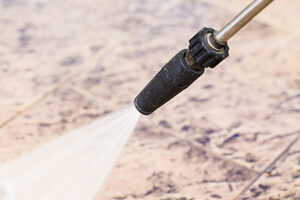New concrete can dramatically improve the look of your property—whether it’s a driveway, patio, sidewalk, or garage floor. But just like any surface, concrete is prone to collecting dirt, grime, mold, and stains. When it’s time to clean it, many homeowners turn to pressure washing. However, when dealing with newer concrete, it’s important to proceed with care. Using the wrong pressure washing technique can do more harm than good.

Click here to see video
Why New Concrete Needs Special Attention
Concrete may look tough, but freshly poured slabs are surprisingly vulnerable. It takes about 28 days for concrete to fully cure and develop its strength. Even after that, concrete continues to harden and settle for months. During this time, the surface is more susceptible to etching, pitting, or cracking—especially if exposed to high-pressure water or harsh chemicals.
The Risks of Incorrect Pressure Washing
Using the wrong pressure setting or nozzle can:
-
Etch the surface: Too much pressure can carve lines or roughen up the surface.
-
Expose aggregate: Stripping away the top layer can expose the stones inside the concrete, leading to premature wear.
-
Force water into cracks: High pressure can drive water into small surface cracks or joints, potentially worsening them over time.
Best Practices for Pressure Washing Newer Concrete
If your concrete is less than a year old, here’s how to clean it safely and effectively:
1. Wait Until It’s Cured
Only pressure wash concrete after it has fully cured—generally at least 28 days after pouring. If in doubt, consult your contractor or supplier.
2. Start with a Low Pressure
Begin with a lower setting (around 2,000–2,500 PSI). This is usually strong enough to remove dirt without damaging the surface.
3. Use the Right Nozzle
A 25-degree nozzle (green tip) offers a good balance of pressure and surface coverage. Avoid the red zero-degree nozzle, which is too harsh for newer concrete.
4. Test First
Always test in a small, inconspicuous area before cleaning the whole surface. This ensures your setup won’t cause damage.
5. Use Gentle Detergents
Opt for concrete-safe, biodegradable cleaners. Avoid acidic or harsh chemical cleaners that could weaken the concrete or affect sealants.
6. Keep a Consistent Distance
Maintain a 12–18 inch distance between the nozzle and the surface. Moving too close can result in uneven cleaning or permanent marks.
7. Seal After Cleaning
After a thorough clean, consider sealing the concrete. A quality sealer protects against stains, moisture, and future grime buildup—keeping your concrete looking newer for longer.
Final Thoughts
Pressure washing is an excellent way to maintain newer concrete, but only if done correctly. Using the right technique can extend the life of your investment and preserve its clean, fresh appearance. When in doubt, consider hiring a professional who understands how to handle newer surfaces with care.
Just A Man Power Washing provides pressure washing services in Clearwater, Florida and the surrounding area.
For more information, visit our web site https://pressurewashingclearwater.net/ or call (727) 225-1337.
